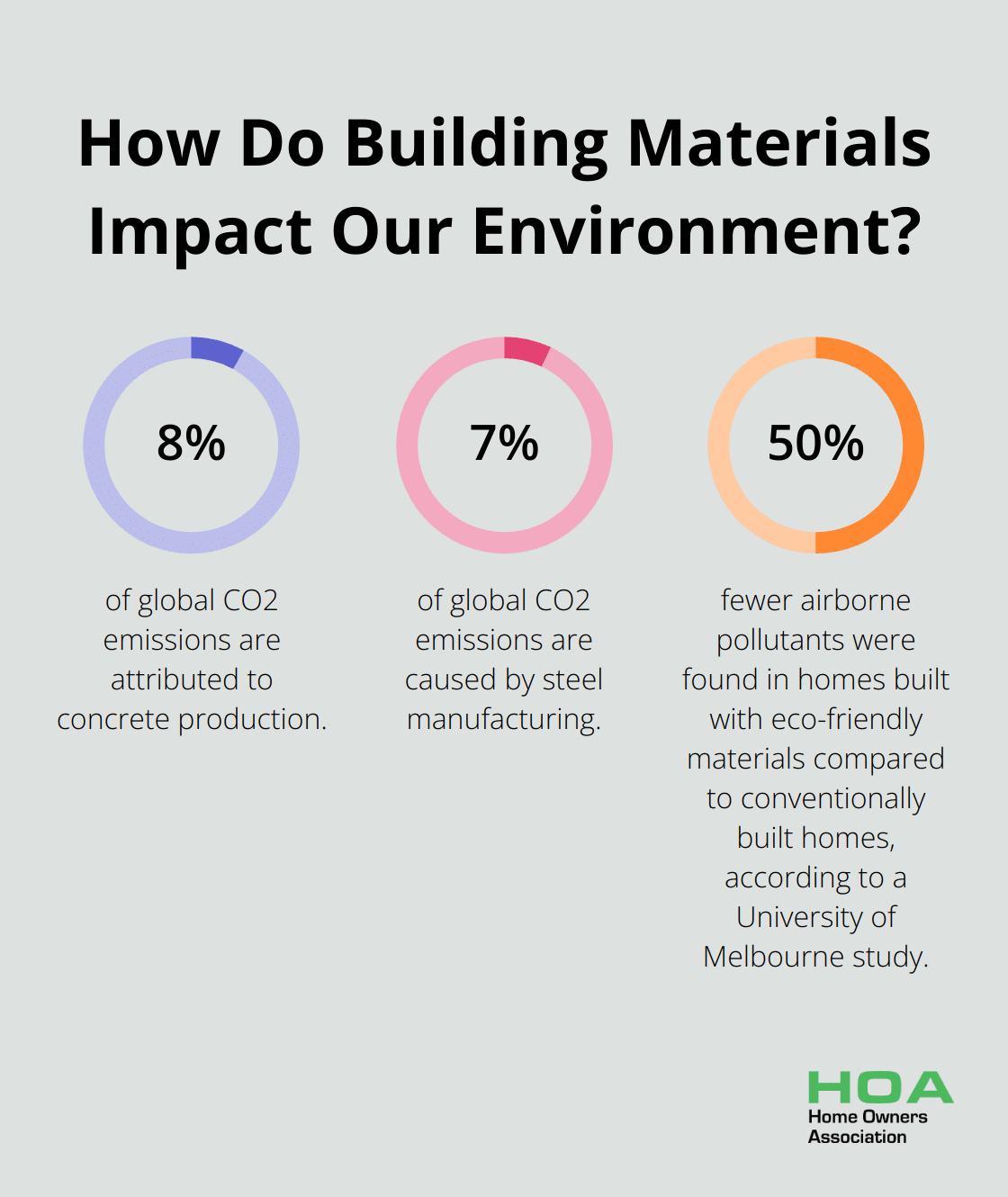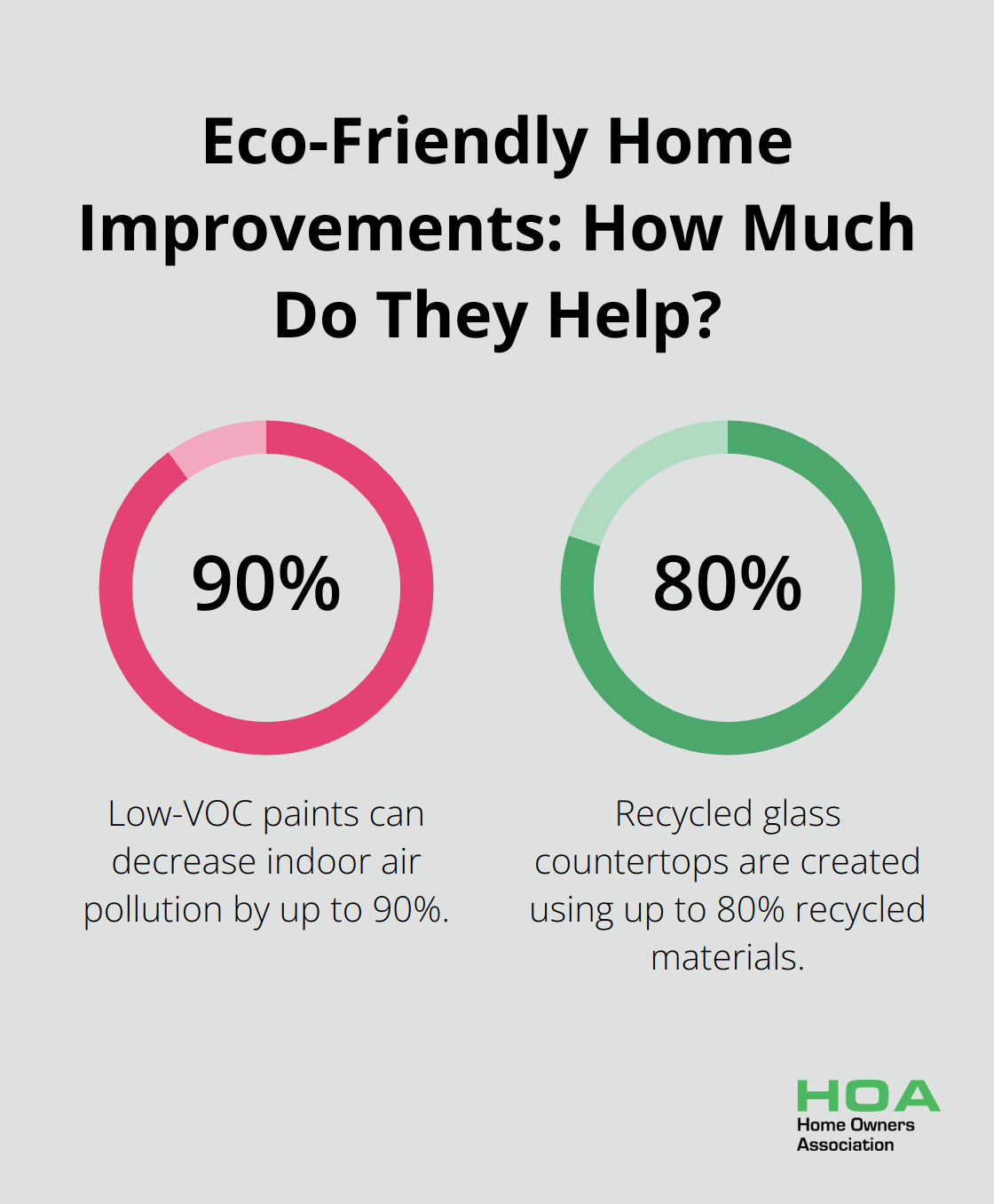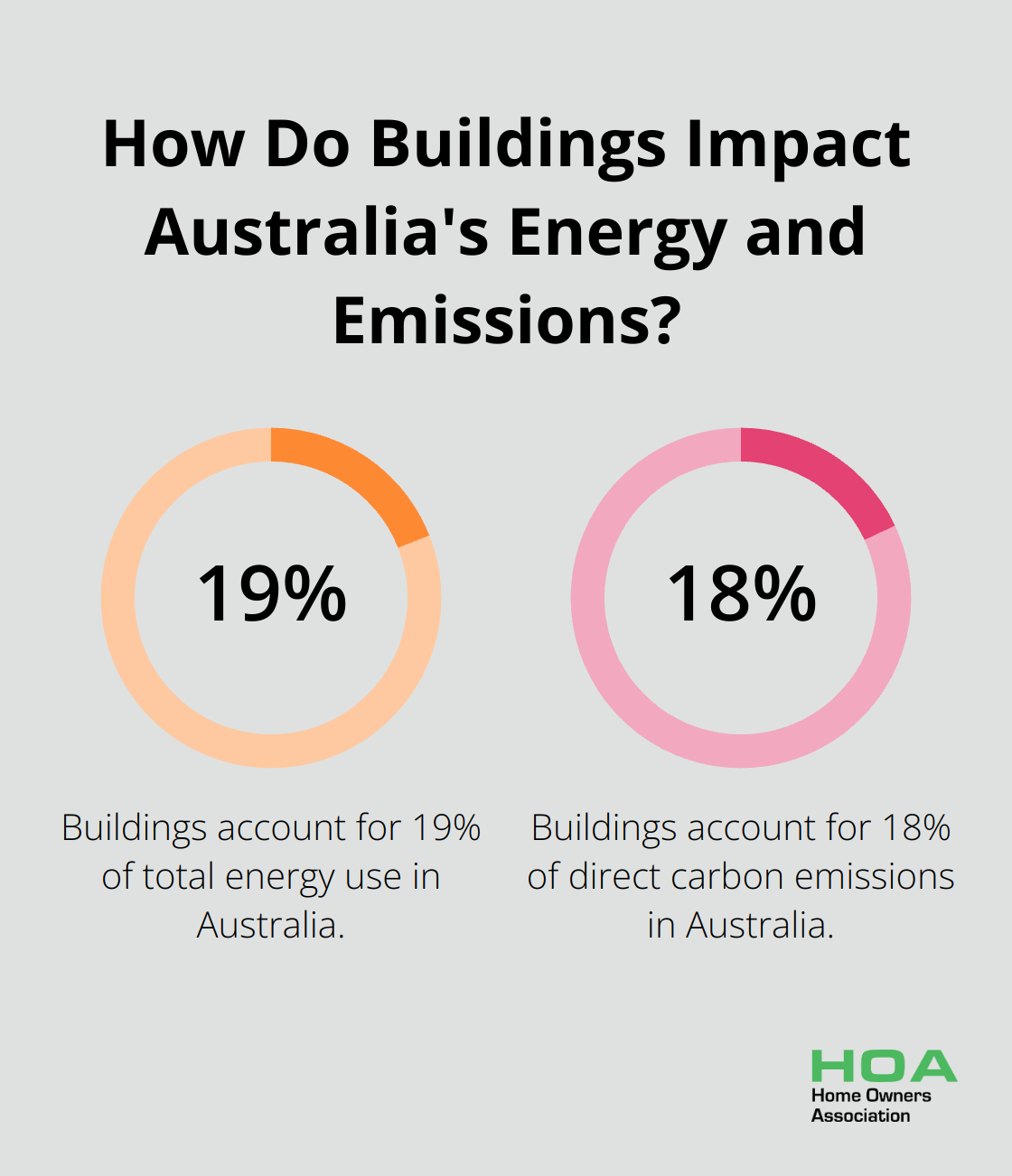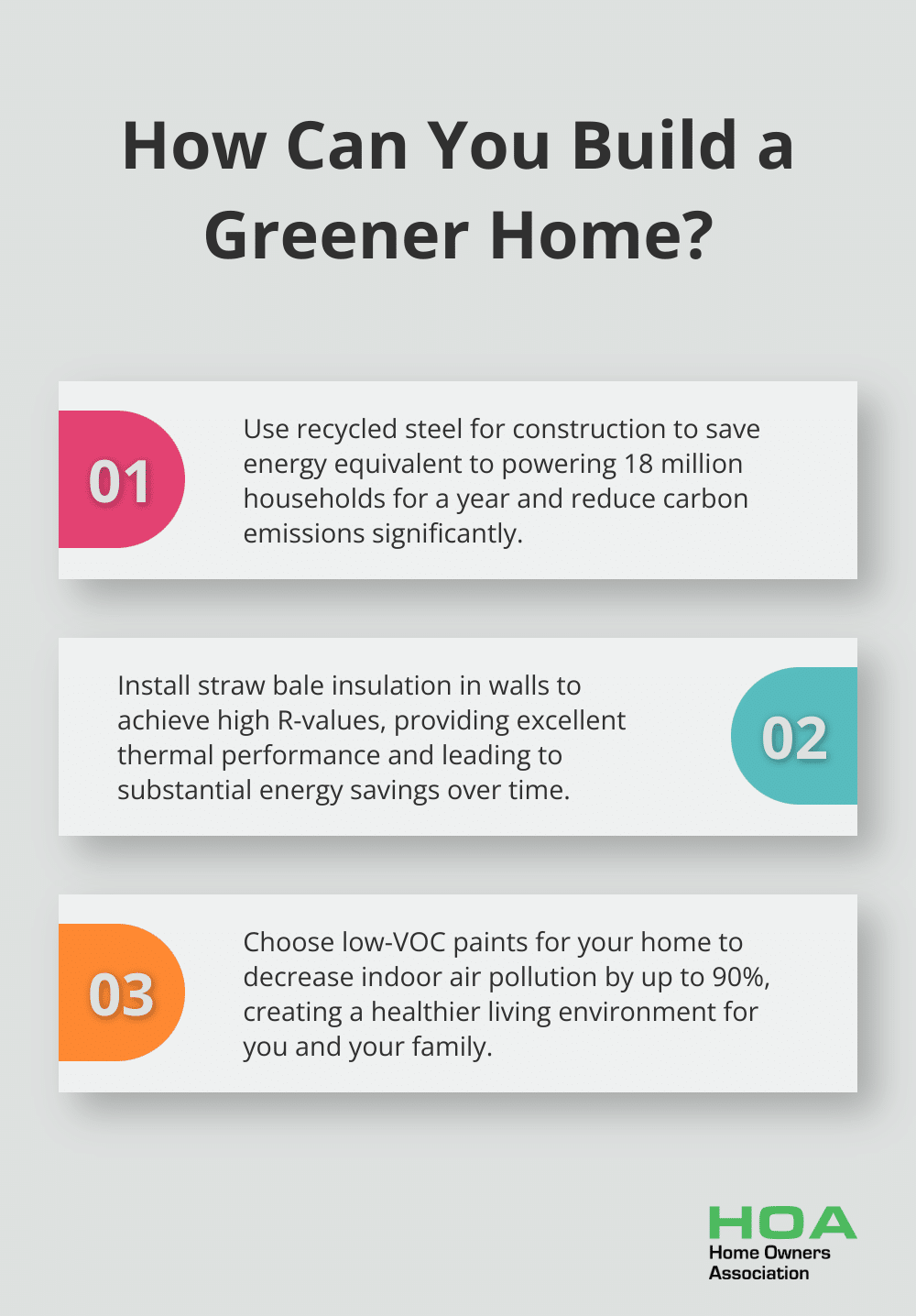
At Home Owners Association, we understand the growing importance of sustainable construction practices. Building materials for eco-friendly houses are becoming increasingly popular among homeowners who want to reduce their environmental impact.
This blog post will guide you through the process of selecting eco-friendly building materials for your home. We’ll explore top sustainable options, factors to consider, and the long-term benefits of making environmentally conscious choices in your construction or renovation project.
What Are Eco-Friendly Building Materials?
Definition and Environmental Impact
Eco-friendly building materials minimize environmental impact throughout their lifecycle. These products are sourced, manufactured, and disposed of in ways that conserve natural resources, reduce pollution, and promote sustainability.

Traditional construction materials often come with a significant environmental cost. Concrete production accounts for about 8% of global CO2 emissions, while steel manufacturing is responsible for approximately 7%. These statistics highlight the urgent need for sustainable alternatives in the construction industry.
Sustainable Alternatives and Their Benefits
Switching to eco-friendly building materials offers numerous advantages. Bamboo flooring, for example, can be harvested every 3-5 years (compared to hardwoods which take 20-120 years to mature). This rapid regeneration makes bamboo a highly sustainable choice.
Recycled steel presents another excellent option. The Steel Recycling Institute reports that using recycled steel in construction saves enough energy to power 18 million households for a year. This substantial energy saving translates to reduced carbon emissions and lower environmental impact.
Energy Efficiency and Cost Savings
Many eco-friendly materials offer superior insulation properties. Straw bale insulation can achieve high R-values for walls, providing excellent thermal performance. This improved insulation can lead to substantial energy savings over time.
Health Benefits of Eco-Friendly Materials
Eco-friendly materials often contribute to healthier indoor environments. Traditional building materials can release volatile organic compounds (VOCs) that negatively impact air quality. In contrast, materials like low-VOC paints and natural insulation improve indoor air quality by reducing harmful emissions.
A study by the University of Melbourne found that homes built with eco-friendly materials had 50% fewer airborne pollutants compared to conventionally built homes. This improvement in air quality can lead to better respiratory health for occupants.
The Role of Certifications
To ensure the authenticity of eco-friendly claims, various certifications exist. The Forest Stewardship Council (FSC) certification, for instance, guarantees that wood products come from responsibly managed forests. The Green Seal certification identifies products that meet rigorous environmental standards. These certifications help consumers make informed choices when selecting building materials.
As we move forward, it’s essential to understand the specific eco-friendly building materials available for home construction. Let’s explore some top options in the next section.
Eco-Friendly Building Materials for Your Home
Recycled Steel and Reclaimed Wood
Recycled steel transforms construction sustainability. Production of new steel by recycling steel requires up to 10 times less energy than the production of steel from virgin iron ore. This significant decrease translates to lower carbon emissions in the building process.
Reclaimed wood offers both environmental benefits and unique aesthetics. The National Association of Home Builders estimates that using reclaimed wood can reduce landfill waste by up to 8,000 pounds for a 2,000 square foot home. This choice not only preserves forests but also adds character to your living space.
Natural and Renewable Resources
Bamboo flooring has become a popular eco-friendly option. Its rapid growth cycle (3-5 years) outpaces traditional hardwoods, which can take decades to mature. This quick regeneration makes bamboo a highly sustainable choice for homeowners.

Cork, harvested from the bark of cork oak trees, provides excellent insulation and sound absorption. Its natural properties make it an ideal material for flooring and wall coverings in eco-conscious homes.
Hempcrete, a mixture of hemp hurds and lime, has gained traction in Australian construction. Hemp plants absorb large amounts of carbon dioxide during their growth, making hempcrete a carbon-negative material. This means that it’s an excellent choice for environmentally conscious builders.
Low-VOC Paints and Finishes
Traditional paints often release high levels of volatile organic compounds (VOCs), which can negatively impact indoor air quality. Low-VOC paints significantly reduce these harmful emissions. A study by the Commonwealth Scientific and Industrial Research Organisation (CSIRO) found that low-VOC paints can decrease indoor air pollution by up to 90%. This reduction creates a healthier living environment for homeowners and their families.
Recycled Glass Countertops
Recycled glass countertops offer both style and sustainability. Manufacturers create these durable surfaces using up to 80% recycled materials. Their longevity reduces the need for replacement, further conserving resources over time. The unique patterns and colors available in recycled glass countertops allow homeowners to express their style while making an eco-friendly choice.
The selection of eco-friendly building materials involves more than just choosing sustainable options. Homeowners must consider various factors to ensure their choices align with their overall construction goals and environmental values. In the next section, we’ll explore the key considerations when selecting eco-friendly materials for your home project.
How to Evaluate Eco-Friendly Building Materials
Energy Efficiency and Insulation
Energy efficiency stands as a top priority when you select eco-friendly materials. The National Construction Code of Australia sets minimum energy efficiency standards for new homes and renovations. To exceed these standards, select materials with high R-values (which measure thermal resistance). Straw bale insulation, for example, can achieve R-values of up to 2.38 per inch, which significantly outperforms traditional fiberglass insulation.

Proper insulation reduces your carbon footprint and leads to substantial energy savings. Buildings account for around 19% of total energy use and 18% of direct carbon emissions in Australia. When you choose insulation materials, consider options like recycled denim, sheep’s wool, or cellulose made from recycled paper products.
Durability and Life Cycle Costs
Durability plays a key role in truly sustainable building materials. Long-lasting materials minimize the need for replacements, which reduces waste and resource consumption over time. Fiber cement siding, for instance, can last up to 50 years (compared to vinyl siding’s typical lifespan of 20-30 years).
Evaluate the entire life cycle of materials, from production to disposal. The Green Building Council of Australia provides Life Cycle Assessment tools to help you assess the environmental impact of different materials throughout their use. This approach ensures you make choices that remain sustainable in the long term, not just at the point of purchase.
Local Sourcing and Transportation
Source materials locally to reduce transportation-related emissions and support the Australian economy. Research suppliers in your area and prioritize those within a 160-kilometer radius to minimize transportation impacts.
Certifications and Eco-Labels
Look for certifications like the Good Environmental Choice Australia (GECA) label, which ensures products meet rigorous environmental standards. The Forest Stewardship Council (FSC) certification proves essential for wood products, as it sets the standard for responsible forest stewardship.
Budget Considerations
While eco-friendly materials may have higher upfront costs, they often result in long-term savings through energy efficiency and durability. Balance initial expenses against potential long-term benefits (such as lower energy bills and reduced maintenance costs) when you make your selections.
Final Thoughts
Choosing eco-friendly building materials for your home will create a more sustainable future. These materials reduce carbon emissions, improve indoor air quality, and preserve our planet’s resources. Options like recycled steel, reclaimed wood, and low-VOC paints contribute to a healthier living environment and offer long-term advantages.

Energy-efficient materials lead to significant cost savings on utility bills. Durable options reduce the need for frequent replacements. Homes built with building materials for eco-friendly houses often see higher property values as sustainability becomes increasingly valued in the real estate market.
We at Home Owners Association encourage you to make sustainable choices in your home construction and renovation projects. Our team in Melbourne, Australia, supports homeowners with expert advice, access to trade pricing, and educational resources (to ensure your eco-friendly building projects succeed). You will create a legacy of environmental responsibility for future generations when you choose sustainable materials for your home.





